 Physiological
Support Division
Physiological
Support Division Physiological
Support Division
Physiological
Support Division9th Strategic Reconnaissance Wing
Beale AFB, California
"A Day in the Life of a PSD Technician"
by Kevin Svetcos, Beale AFB
PSD Instructor
Photos as marked Courtesy Paul F. Crickmore
Author of "Lockheed SR-71, the Mach 3 Blackbird"

PSD Preflight Activity
Flight Day minus 1:
Preparations to launch an SR-71 aircraft began the day before. There were always 2 techs assigned per ACM and one supervisor per launch, so that means four techs and a supervisor were assigned to each SR launch while only two and the supervisor for the U-2. Half of the team would conduct pre-flight inspections on the suit and related components, while the other half inspected the parachute and seat kit.
Suit Pre-Flight Inspections
(Kevin Svetcos, Author of this article is shown below
testing a pilot's suit)
(Photo courtesy Paul Crickmore)
 Inspection
of the suit consisted of a visual check of the entire suit for any obvious
flaws or discrepancies, to ensure that parts were where they were supposed
to be, and that there were no tears, gashes, etc., among other things.
Each crewmember had a card in a file that listed sizes of equipment, any
personal preferences for things like face heat settings, personal equipment
and where it was to be stored in the suit for the flight, and those items
were noted and the requests met. The entire suit was assembled, attached
to testing equipment, pressurized, and the results were noted on the pre-flight
check sheet. If a test did not fall within the required parameters,
then either adjustments or repairs were made until the results consistently
fell within the parameters. Every time a test was performed, the
results were noted, and when ever the results did not meet specs, the test
sheet was used later on as a history for trouble-shooting activities.
In the more extreme cases when results were consistently out of range,
then the flier’s second suit was used and the primary was immediately taken
to the suit maintenance section of the unit for attention. It should
be mentioned here that each ACM had one each helmet, one each pair of boots,
two full pressure suits, two parachute harness assemblies and two sets
of gloves. The helmet and gloves were inspected after the pressurized portion
of the pre-flight was completed. The communications systems were
checked, the face heat system in the visor was checked, as well as the
seal between the face cavity in the front of the helmet and the rest of
the helmet. After the helmet was completed, all items were returned
to the storage area, and the parachute harness was checked. It was
checked to make sure there were no twists in the webbing and that all hardware
was present and functional. Another item checked on the harness were
the water wings that were activated either by a manual cord or by a water
sensing aneroid in the case of a parachute landing in water. When
all tests were completed, the paperwork for the suit was left with the
suit for the next day’s preparations. (Seat kit and parachute pre-flight
inspections)
Inspection
of the suit consisted of a visual check of the entire suit for any obvious
flaws or discrepancies, to ensure that parts were where they were supposed
to be, and that there were no tears, gashes, etc., among other things.
Each crewmember had a card in a file that listed sizes of equipment, any
personal preferences for things like face heat settings, personal equipment
and where it was to be stored in the suit for the flight, and those items
were noted and the requests met. The entire suit was assembled, attached
to testing equipment, pressurized, and the results were noted on the pre-flight
check sheet. If a test did not fall within the required parameters,
then either adjustments or repairs were made until the results consistently
fell within the parameters. Every time a test was performed, the
results were noted, and when ever the results did not meet specs, the test
sheet was used later on as a history for trouble-shooting activities.
In the more extreme cases when results were consistently out of range,
then the flier’s second suit was used and the primary was immediately taken
to the suit maintenance section of the unit for attention. It should
be mentioned here that each ACM had one each helmet, one each pair of boots,
two full pressure suits, two parachute harness assemblies and two sets
of gloves. The helmet and gloves were inspected after the pressurized portion
of the pre-flight was completed. The communications systems were
checked, the face heat system in the visor was checked, as well as the
seal between the face cavity in the front of the helmet and the rest of
the helmet. After the helmet was completed, all items were returned
to the storage area, and the parachute harness was checked. It was
checked to make sure there were no twists in the webbing and that all hardware
was present and functional. Another item checked on the harness were
the water wings that were activated either by a manual cord or by a water
sensing aneroid in the case of a parachute landing in water. When
all tests were completed, the paperwork for the suit was left with the
suit for the next day’s preparations. (Seat kit and parachute pre-flight
inspections)
On the other side of the equation, the seat kit and parachute was
being checked as well. Current inspections and packing schedules
were checked on the chute along with the locator beacon and plunger, coke
fittings used to attach to the harness and several tackings used to secure
cords until they were (hopefully never) needed. The seat kit was
checked for physical integrity; no cracks in the plastic shell, O2 lanyards
and hoses in place and safety wire secure, O2 bottles full and functional,
and seat cushion in good condition. 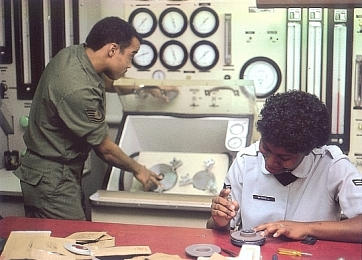 Finally,
a communications (comm.) cord to connect the ACM to the aircraft’s communications
system, and vent hose to connect them to the environmental systems were
chosen and logged onto the pre-flight inspection sheet. As with the
suit, if there were any discrepancies at all in regards to the safety or
security of any of the equipment, it was either repaired or taken out of
service and replaced with an acceptable piece of equipment. All items
were stored together, waiting to be installed into the aircraft the following
day. During pre-flight inspections, it was not unheard of for
a tech to set aside what was an otherwise perfectly operating piece of
equipment if it did not “feel” or “look” right to them. All anyone
had to say at any point in any inspection was, “I don’t like it”, and it
was out of service – and remained out of service – until further tests
and inspections were run, absolutely no questions asked. This was
true for everyone from the most seasoned techs all the way to the newest
trainee just learning the business of aircraft launch and recovery. (Suit
Valves are checked for leakage. Airman Mitchell (Rt.) is shown assembling
a pressure valve.) (Crickmore)
Finally,
a communications (comm.) cord to connect the ACM to the aircraft’s communications
system, and vent hose to connect them to the environmental systems were
chosen and logged onto the pre-flight inspection sheet. As with the
suit, if there were any discrepancies at all in regards to the safety or
security of any of the equipment, it was either repaired or taken out of
service and replaced with an acceptable piece of equipment. All items
were stored together, waiting to be installed into the aircraft the following
day. During pre-flight inspections, it was not unheard of for
a tech to set aside what was an otherwise perfectly operating piece of
equipment if it did not “feel” or “look” right to them. All anyone
had to say at any point in any inspection was, “I don’t like it”, and it
was out of service – and remained out of service – until further tests
and inspections were run, absolutely no questions asked. This was
true for everyone from the most seasoned techs all the way to the newest
trainee just learning the business of aircraft launch and recovery. (Suit
Valves are checked for leakage. Airman Mitchell (Rt.) is shown assembling
a pressure valve.) (Crickmore)
Flight Day:
(Photo Below - Habu's Tom Veltri and Duane Noll
receive pre-flight physicals. (Crickmore Photo)
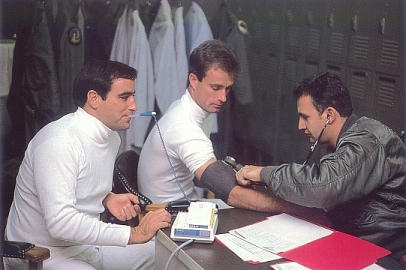 The
morning of the flight, the parachute, seat kit, comm. cord and vent hose
were taken to the aircraft. About 2 hours prior to take off, the
suit was laid out in the suit up area: the suit was set in front
of the chair the crew member would be using while donning (putting on)
the suit. Arms and legs were pulled out as far as possible, the parachute
harness was set out, boots, gloves, nylon glove inserts used not only for
ease of putting on and taking off the gloves, but also for absorbing sweat,
and the “spurs” the pilots wore on their boots as part of the egress equipment.
These will be covered later on. While it was not a formal policy,
the normal routine was that whoever pre-flighted the suit loaded the plane,
and whoever pre-flighted the seat and chute laid out the suit in order
to get “fresh eyes” on the equipment. Of course, there were times
when a person had to do both the load and layout if their partner was already
involved in another flight and was unable to fulfill their usual obligations.
No matter what the case was, however, the supervisor always came through
and checked the suit layout, and was present and involved from the time
the crew member’s started getting dressed to the time the canopy was closed
just before taxi. What was a policy, however, was that when a cockpit
was loaded or a suit laid out, the two techs performing these tasks would
switch sides and double-check the other’s work from the first step to the
last. In the case of the cockpit loading, a checklist was always
always ALWAYS present and referred to during installation and checks, even
by those who had performed the same task literally hundreds of times before.
Unit pride was encouraged; self-pride was dealt with harshly.
The
morning of the flight, the parachute, seat kit, comm. cord and vent hose
were taken to the aircraft. About 2 hours prior to take off, the
suit was laid out in the suit up area: the suit was set in front
of the chair the crew member would be using while donning (putting on)
the suit. Arms and legs were pulled out as far as possible, the parachute
harness was set out, boots, gloves, nylon glove inserts used not only for
ease of putting on and taking off the gloves, but also for absorbing sweat,
and the “spurs” the pilots wore on their boots as part of the egress equipment.
These will be covered later on. While it was not a formal policy,
the normal routine was that whoever pre-flighted the suit loaded the plane,
and whoever pre-flighted the seat and chute laid out the suit in order
to get “fresh eyes” on the equipment. Of course, there were times
when a person had to do both the load and layout if their partner was already
involved in another flight and was unable to fulfill their usual obligations.
No matter what the case was, however, the supervisor always came through
and checked the suit layout, and was present and involved from the time
the crew member’s started getting dressed to the time the canopy was closed
just before taxi. What was a policy, however, was that when a cockpit
was loaded or a suit laid out, the two techs performing these tasks would
switch sides and double-check the other’s work from the first step to the
last. In the case of the cockpit loading, a checklist was always
always ALWAYS present and referred to during installation and checks, even
by those who had performed the same task literally hundreds of times before.
Unit pride was encouraged; self-pride was dealt with harshly.
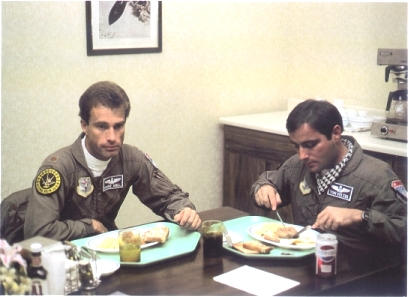 When
the crewmembers began getting ready to get dressed in their suits, they
came down to the dressing room from the kitchen where they had their high
protein/low residue pre-flight meal of steak and eggs. The steak
and eggs were a crucial part of the flight because of the high nutritional
value it contained, which sustained the pilots for their long flights.
(Right
Photo - Crew Tom Veltri and Duane Noll have a high protein breakfast.)
(Crickmore Photo.) This meal also was digested slower by the body,
which in turn significantly extended the amount time between eating and
the need to evacuate the bowels. In the dressing room, they changed
into a set of 100% cotton long underwear tops (a mock turtleneck) and bottoms,
and socks. Because of the length of some of the missions, the pilots
sometimes wore a UCD (urine collection device) that had a tube that attached
to a manually operated valve on the inside left leg. On the suits
worn by the SR crews, the hose connected to a bag (a.k.a. the "piddle pack")
on the inside of the lower left leg their suit, while the U-2/TR-1 crews
had an external hose that emptied into a container under the floorboard
of the plane. If at any time during the flight the ACM felt he had
to relieve himself, he would simply inflate the suit a little to create
an airflow, OPEN THE VALVE FIRST that would allow the flow of the urine
to the bag, urinate, THEN close the valve again. Before going out
to get dressed, one of the PSD techs would take the crewmember’s blood
pressure, pulse, temperature, their last meal’s content and time prior
to the steak and eggs they just had, and their times to sleep and awake.
This was used by the flight doctors as a history should any of the ACs
report any physiological incidents either during or following their flight.
It was at this time that they were asked if they wanted to take anything
to drink or eat for the flight. Drinks that were taken were usually
Gatorade or water in special bottles for rehydration, and the food came
packaged in aluminum toothpaste tubes with a special probe that would fit
into a small port on the lower left side of the helmet (applesauce and
butterscotch pudding were the most popular).
When
the crewmembers began getting ready to get dressed in their suits, they
came down to the dressing room from the kitchen where they had their high
protein/low residue pre-flight meal of steak and eggs. The steak
and eggs were a crucial part of the flight because of the high nutritional
value it contained, which sustained the pilots for their long flights.
(Right
Photo - Crew Tom Veltri and Duane Noll have a high protein breakfast.)
(Crickmore Photo.) This meal also was digested slower by the body,
which in turn significantly extended the amount time between eating and
the need to evacuate the bowels. In the dressing room, they changed
into a set of 100% cotton long underwear tops (a mock turtleneck) and bottoms,
and socks. Because of the length of some of the missions, the pilots
sometimes wore a UCD (urine collection device) that had a tube that attached
to a manually operated valve on the inside left leg. On the suits
worn by the SR crews, the hose connected to a bag (a.k.a. the "piddle pack")
on the inside of the lower left leg their suit, while the U-2/TR-1 crews
had an external hose that emptied into a container under the floorboard
of the plane. If at any time during the flight the ACM felt he had
to relieve himself, he would simply inflate the suit a little to create
an airflow, OPEN THE VALVE FIRST that would allow the flow of the urine
to the bag, urinate, THEN close the valve again. Before going out
to get dressed, one of the PSD techs would take the crewmember’s blood
pressure, pulse, temperature, their last meal’s content and time prior
to the steak and eggs they just had, and their times to sleep and awake.
This was used by the flight doctors as a history should any of the ACs
report any physiological incidents either during or following their flight.
It was at this time that they were asked if they wanted to take anything
to drink or eat for the flight. Drinks that were taken were usually
Gatorade or water in special bottles for rehydration, and the food came
packaged in aluminum toothpaste tubes with a special probe that would fit
into a small port on the lower left side of the helmet (applesauce and
butterscotch pudding were the most popular).
Suit-up and Systems Checks
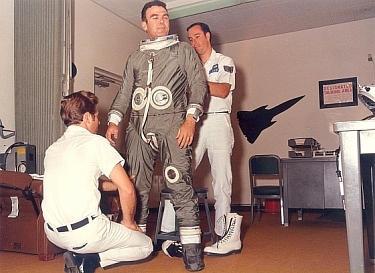 Two
PSD techs would assist in the suit-up. When the crews were ready,
they would come out and sit in the chairs behind their suits. On
occasion, there would be a tour going through PSD. If this were the
case during one of the times that a crew member was wearing a UCD, they
would usually wear a bathrobe out and take it off while they were sitting
in the chair due to the nature of the equipment. The suit was a rear-entry
suit, and the ACs literally stepped into them like they were stepping into
a new skin. Feet in first and connect the UCD if required, secured
with a piece of electrical tape. Next came the arms, then the head
through the neck ring. After that, they stood up and did some adjustments
to get the suit to fall as comfortable as possible along their arms and
legs, reaching in to adjust underwear or suit liners for comfort before
having both of the heavy-duty zippers closed and snapped shut. (Left
Photo - Colonel Jerry O'Malley, Wing Commander (1972-1973) is shown here
with the bladder suit installed and closed up.)
Two
PSD techs would assist in the suit-up. When the crews were ready,
they would come out and sit in the chairs behind their suits. On
occasion, there would be a tour going through PSD. If this were the
case during one of the times that a crew member was wearing a UCD, they
would usually wear a bathrobe out and take it off while they were sitting
in the chair due to the nature of the equipment. The suit was a rear-entry
suit, and the ACs literally stepped into them like they were stepping into
a new skin. Feet in first and connect the UCD if required, secured
with a piece of electrical tape. Next came the arms, then the head
through the neck ring. After that, they stood up and did some adjustments
to get the suit to fall as comfortable as possible along their arms and
legs, reaching in to adjust underwear or suit liners for comfort before
having both of the heavy-duty zippers closed and snapped shut. (Left
Photo - Colonel Jerry O'Malley, Wing Commander (1972-1973) is shown here
with the bladder suit installed and closed up.)
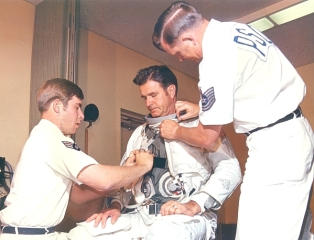 Next
came the harness. It was nothing more than a torso suit with no legs
or arms, but it did contain an intricate and purposeful maze of webbing
designed to give the AC support in case of egress as well as comfort.
They stepped into it feet first, then arms, and then sat down. By
that time one of the PSD techs would be behind the AC and then grab them
by the harness at the shoulders, then bounced up and down to ensure there
was no slack in the harness. It was hooked together and snugged up
according to the pilot’s comfort, then the harness cover was zipped up
and secured. After that, the boots were put on, followed by the spurs.
(Right
Photo - Colonel Hal Confer, 9th SRW Wing Commander (1970-1972) gets adjustments
to his outer suit.)
Next
came the harness. It was nothing more than a torso suit with no legs
or arms, but it did contain an intricate and purposeful maze of webbing
designed to give the AC support in case of egress as well as comfort.
They stepped into it feet first, then arms, and then sat down. By
that time one of the PSD techs would be behind the AC and then grab them
by the harness at the shoulders, then bounced up and down to ensure there
was no slack in the harness. It was hooked together and snugged up
according to the pilot’s comfort, then the harness cover was zipped up
and secured. After that, the boots were put on, followed by the spurs.
(Right
Photo - Colonel Hal Confer, 9th SRW Wing Commander (1970-1972) gets adjustments
to his outer suit.)
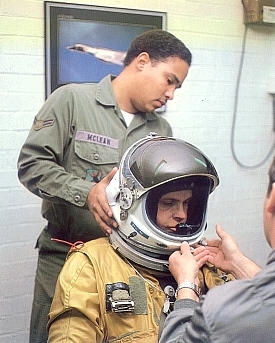 After
that, the helmet was put on. With standard helmets, the practice
was to put it on from the back; but with these helmets, they were rolled
on like a football helmet, chin first. The neoprene rubber barrier
that separated the face cavity from the rest of the suit was seated around
the ACs face, then adjusted by a small wheel towards the back of the helmet,
which helped keep their face snug up against the seal. This part
was crucial because keeping the face totally sealed off from the rest of
the suit maintained a 100% O2 environment for the AC to breathe in and
avoid hypoxia. It was also important to maintain this separation
because when the suit was fully inflated, the barometric equivalent (atmospheric
pressure) that the crewmember was exposed to was still equal to being approximately
at 32,000 ft., which is still very dangerous in regards to breathing and
warding off hypoxia, or oxygen deprivation. The separate face cavity
allowed the ACM to maintain a 1-to-1 (ground level) pressure ratio while
breathing, regardless of the pressure inside the suit. (Pilot Major
Brian Shul is assisted by PSD Airman Mclean on his helmet. (Crickmore Photo)
After
that, the helmet was put on. With standard helmets, the practice
was to put it on from the back; but with these helmets, they were rolled
on like a football helmet, chin first. The neoprene rubber barrier
that separated the face cavity from the rest of the suit was seated around
the ACs face, then adjusted by a small wheel towards the back of the helmet,
which helped keep their face snug up against the seal. This part
was crucial because keeping the face totally sealed off from the rest of
the suit maintained a 100% O2 environment for the AC to breathe in and
avoid hypoxia. It was also important to maintain this separation
because when the suit was fully inflated, the barometric equivalent (atmospheric
pressure) that the crewmember was exposed to was still equal to being approximately
at 32,000 ft., which is still very dangerous in regards to breathing and
warding off hypoxia, or oxygen deprivation. The separate face cavity
allowed the ACM to maintain a 1-to-1 (ground level) pressure ratio while
breathing, regardless of the pressure inside the suit. (Pilot Major
Brian Shul is assisted by PSD Airman Mclean on his helmet. (Crickmore Photo)
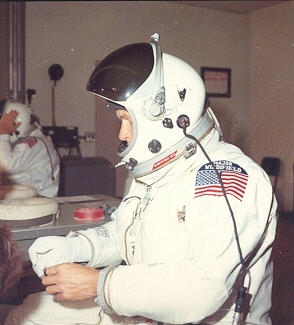 The
gloves were put on last, then locked to the suit with locking rings, and
the rings in turn were covered by flaps secured by Velcro to ensure that
they were not damaged or otherwise compromised by the ACs during the course
of performing their duties in the cockpit.
The
gloves were put on last, then locked to the suit with locking rings, and
the rings in turn were covered by flaps secured by Velcro to ensure that
they were not damaged or otherwise compromised by the ACs during the course
of performing their duties in the cockpit.
After the dressing, they moved about 3 feet over and sat down in
a recliner while the PSD techs hooked them up to testing equipment, and
then the exact same tests were run on the suit as the day before while
it was unoccupied. One tech ran the systems tests and maintained
constant communication with the crewmember, calling out the results of
the tests as performed to the second tech, who would write down all readings
and comments that were made. Again, results were noted and any discrepancies
were identified and addressed, and yes, there was an occasion where the
suit did not perform as it should have. The backup was brought in,
quickly pre-flighted and the AC had to undress and re-dress in the new
suit – all without compromising the safety of the crew member or delaying
the original take-off time. Every step of the way from the very first
foot into the suit to the very last communication check, everything is
checked for comfort. The most oft-used phrase during the entire process
is, “How does that feel?”
 During
the pressure checks, the ACs lower and lock their visors to get a good
seal and begin the flow of O2 through their helmets. It is only after
the systems checks are completed when the difference between the two aircraft
is truly noticed. After the SR crews are finished with their systems
checks, then can open their visors again, but the U-2/TR-1 pilots must
keep their visors down and locked to start their pre-breathe time.
All of the high-fliers had to pre-breathe 100% O2 for an hour before getting
to altitude. Because the U-2s climbed to their operational altitudes
almost immediately after take off, they had to sit in the suit up room
for almost 30 minutes before going out to the airplane. The Sled
jocks, however, did not have to lock their visors and breathe 100% until
just before their safety pins were pulled from the aircraft’s egress systems.
This was because they had to meet up with on of the KC-135/Qs to top off
their gas tank prior to climbing to altitude. (Left Photo - PSD performs
suit check with RSO Noel Widdifield)
During
the pressure checks, the ACs lower and lock their visors to get a good
seal and begin the flow of O2 through their helmets. It is only after
the systems checks are completed when the difference between the two aircraft
is truly noticed. After the SR crews are finished with their systems
checks, then can open their visors again, but the U-2/TR-1 pilots must
keep their visors down and locked to start their pre-breathe time.
All of the high-fliers had to pre-breathe 100% O2 for an hour before getting
to altitude. Because the U-2s climbed to their operational altitudes
almost immediately after take off, they had to sit in the suit up room
for almost 30 minutes before going out to the airplane. The Sled
jocks, however, did not have to lock their visors and breathe 100% until
just before their safety pins were pulled from the aircraft’s egress systems.
This was because they had to meet up with on of the KC-135/Qs to top off
their gas tank prior to climbing to altitude. (Left Photo - PSD performs
suit check with RSO Noel Widdifield)
Aircraft Integration

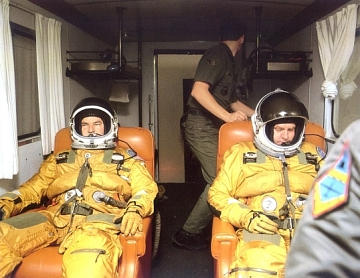
When it was time, portable liquid O2 coolers were attached to the
crew’s suits so they could remain cool. When the crews got to the
airplane, they would wait for the all-clear from their support crew and
the plane’s crew chief before leaving the van and climbing down to entering
the cockpit.
 Once
in, there would be a PSD tech on either side of the crewmember to make
all the necessary attachments to the seat kit, communications, face heat
and oxygen systems, parachute and egress systems. One of the egress items
was the spurs mentioned previously. Based on a ball-and-socket design
much like the chain used for some key chains or on dog tags, there were
two cables that were attached to retractable fixtures with a spring-loaded
ball on one end and a take-up reel in the ejection seat itself. The
balls snapped into these sockets on the back of these spurs that were attached
to the crew member’s boots. This was so that if the AC had to eject
from the plane, part of the sequence was that the take-up reel would wind
up the cable, thereby bringing in the ACs feet close to the seat so they
would leave the cockpit with their feet still attached to their bodies,
and not ripped off and lying on the floor of the plane because they didn’t
pull their feet back completely or in time.
Once
in, there would be a PSD tech on either side of the crewmember to make
all the necessary attachments to the seat kit, communications, face heat
and oxygen systems, parachute and egress systems. One of the egress items
was the spurs mentioned previously. Based on a ball-and-socket design
much like the chain used for some key chains or on dog tags, there were
two cables that were attached to retractable fixtures with a spring-loaded
ball on one end and a take-up reel in the ejection seat itself. The
balls snapped into these sockets on the back of these spurs that were attached
to the crew member’s boots. This was so that if the AC had to eject
from the plane, part of the sequence was that the take-up reel would wind
up the cable, thereby bringing in the ACs feet close to the seat so they
would leave the cockpit with their feet still attached to their bodies,
and not ripped off and lying on the floor of the plane because they didn’t
pull their feet back completely or in time.
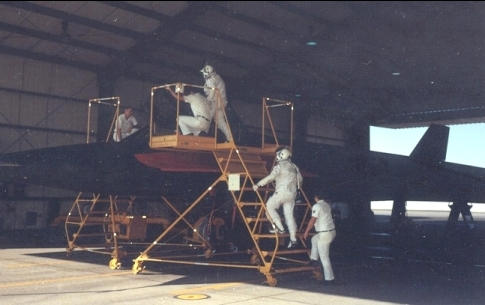
Crew boarding the Blackbird
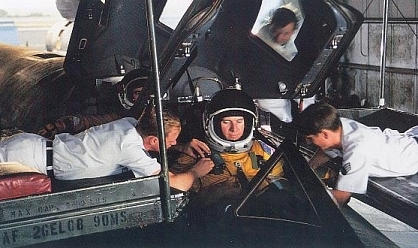 Once
they have finished with their hookups and the ACs have verified proper
function of oxygen, ventilation, face heat and communications, the techs
would change places and read down the checklist for the double-checking
of the hookup. After this was done, the techs would go back to the
vans and wait until just before taxi, at which time they would go up and
pull the safety pins from the pilot’s main “D” ring seat egress, and the
safety cap for the explosive charge contained in the parachute, and take
them back to the van until the plane returned. After that, the canopy
was lowered and locked, and the plane aircrews made final preparations
to fly off and help keep the world safe for democracy. Two of the
PSD techs would return to the unit in order to prepare for other flights
if needed, while the other two and the supervisor would stay out on the
flight line for support until the plane was airborne. They would
radio in to PSD ops when the plane was actually in the air so the flight
time and anticipated recovery could be monitored. (Lockheed Photo)
Once
they have finished with their hookups and the ACs have verified proper
function of oxygen, ventilation, face heat and communications, the techs
would change places and read down the checklist for the double-checking
of the hookup. After this was done, the techs would go back to the
vans and wait until just before taxi, at which time they would go up and
pull the safety pins from the pilot’s main “D” ring seat egress, and the
safety cap for the explosive charge contained in the parachute, and take
them back to the van until the plane returned. After that, the canopy
was lowered and locked, and the plane aircrews made final preparations
to fly off and help keep the world safe for democracy. Two of the
PSD techs would return to the unit in order to prepare for other flights
if needed, while the other two and the supervisor would stay out on the
flight line for support until the plane was airborne. They would
radio in to PSD ops when the plane was actually in the air so the flight
time and anticipated recovery could be monitored. (Lockheed Photo)
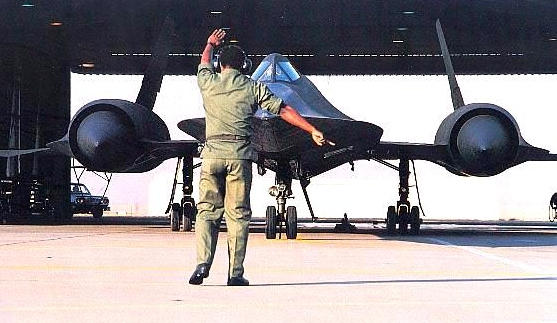
SR-71 Launch at Beale AFB, California (Lockheed Photo)
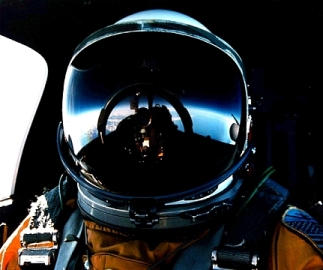
"The Office" (USAF Photo)
 Recovery
Recovery
To recover the aircraft, only one PSD tech was required per ACM,
although if pressed and there were no other bodies available, one could
do it. The supervisor had the choice of either accompanying the recovery
team to the flight line or meeting them at PSD. The general practice
but not the official rule was that whoever launched a plane recovered it.
The recovery team would go out to the flight line about 10 minutes prior
to its scheduled return to the area. Please note here that the key
word is “return” and not “land”. On almost all training flights,
the pilots would take time to practice their take-offs and landings.
Depending on who on the flight line one talked to, they would either hear
these referred to as a “touch-and-go”, or “crash-and-dash”.
After the plane finally landed and taxied in, PSD was on the how-down waiting
for the pilots to open the cockpits so they could safety the seats and
parachutes.
(Taxi in Photo above courtesy Lockheed; Photo below shows Senator
Barry Goldwater after his Mach 3+ flight visiting with Kelly Johnson, the
designer of the SR-71 and Chief Engineer of the Lockheed Skunk Works.) 
After the crew members exited the airplane, water bottles and tube
food were gathered, the crews were escorted to the awaiting PSD van and
the pilots were asked their maximum cabin pressure, time at altitude, if
they used their UCD, and how the suits functioned. Just like before,
all this information was written on the flight sheets. The O2 coolers
were in the vans and hooked to the suits to help cool the crew members
down. After getting back to the building, the suits were taken off in reverse
order of how it was put on. After doffing the suit, the harness was
taken back and hung up where it came from, but the suit, helmet and gloves
were taken to the pre-flight room and hooked onto a vent hose in order
to dry the suit. After the suit was completely dry, then the post-flight
inspection was performed on the suit, which was the exact same as the pre-flight
inspection. If the ACM had no issues with the suit and it passed
the post-flight, then it was returned to its storage unit, along with the
helmet and boots, but if there were some issues identified, the suit was
taken out of service until those issues could be properly addressed, verified
and
put back into service. While the timing for the downloading of the seat
kit, parachute, comm. cord and vent hose was not as crucial as getting
the air crews out, every effort was made to get them out as soon as possible.  This
was not only so that the ground crew could perform their duties, but also
to try and avoid any potential damage to the equipment as well. After
getting back to the unit, the equipment followed the same basic procedure
as the suit: it went through the same inspection in the post-flight
as in the pre-flight, and any and all issues were addressed and verified,
and then returned to service.
This
was not only so that the ground crew could perform their duties, but also
to try and avoid any potential damage to the equipment as well. After
getting back to the unit, the equipment followed the same basic procedure
as the suit: it went through the same inspection in the post-flight
as in the pre-flight, and any and all issues were addressed and verified,
and then returned to service.
And when the next day came, we did it all over again.
Author, Kevin Svetcos
(Photo, right: PSD crew with Pilot Major Adolphus Bledsoe shown wearing the dark brown pressure suit, Model S-1030. Suit was discontinued as it absorbed radiated heat. VIP riding in the "B" Model was Dr. Walter LaBerge (Lt.) and the Crew Chief shown here is SSgt Theodore Holmes in July 1974)
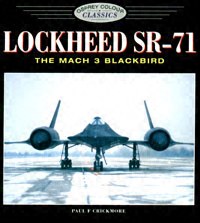
 Paul
F. Crickmore has kindly granted permission to use his copyrighted photos
on this web site. Those photos (as marked) may not be reproduced in any
format without his express written permission. I highly recommend you purchase
his book "Lockheed SR-71 The Mach 3 Blackbird" (The source for these web
site photos).
Paul
F. Crickmore has kindly granted permission to use his copyrighted photos
on this web site. Those photos (as marked) may not be reproduced in any
format without his express written permission. I highly recommend you purchase
his book "Lockheed SR-71 The Mach 3 Blackbird" (The source for these web
site photos).
ISBN # 1- 85532-712-0
In addition Paul has one of the greatest SR-71 books in print titled "SR-71 The Secret Missions Exposed", revised with 40 extra pages.
| SR-71 Front Page | Links Page | Index Page | Recollections | 2001 Reunion |
| "SR-71 Blackbirds" Web Site Navigator | ||||
| First Created: April 15, 1996 - Last Revised: March 29, 2004 | ||||
| Copyright © 1996 Leland R. Haynes Email: sr71webmaster@sr71.us | ||||
This web page is a part of the "SR-71 Blackbirds" website and
was composed and edited by Leland Haynes, Webmaster, "SR-71 Blackbirds".
No portions may be duplicated, copied or stored on any retrieval system.
Copyrighted on March 11, 2001. All rights reserved.
Revised March 29, 2004
Page #57 of the "SR-71 Blackbirds"